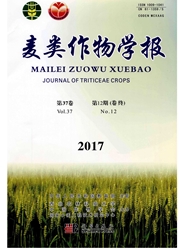

 中文摘要:
中文摘要:
自20世纪"绿色革命"以来,小麦改良进展变缓,"重组加选择"传统遗传改良模式的潜力似乎已挖掘殆尽。同其他物种一样,小麦在发育调控和株型构建等方面存在很多遗传"累赘"(影响生长发育平顺性和效率的性状),正是这些"累赘"赋予了小麦强大的生存和繁衍保障能力。但对于多数农业核心区而言,这些能耗型"累赘"明显多余,难以适应未来设施农业的发展要求。小麦的"累赘"性状主要有两个方面:一是多余的分蘖和茎叶消耗,二是耗时的春化和光周期需求(满足需求之前生长发育非常缓慢)。重组改良或简单的基因工程只能把"累赘"性状适度减弱,而利用快速发展的生物学新技术把控制这些性状的遗传信息彻底剪除才能从根本上消除"累赘"。只有以农耕文明所营造的无逆境环境来取代小麦"累赘"性状所担负的生存繁衍保障责任,解除小麦的逆境灾害之忧,才能使其成为籽粒克隆的生物工厂,彻底解决人类生存的衣食之患。
 英文摘要:
英文摘要:
After the"green revolution"occurred in 1960 sto 1980s,the progress of wheat improvement tends to slow down.Traditional patterns of genetic improvement,the model of"recombination and selection"seems have been fully tapped.Like in many other crops,there are a lot of genetic"encumbrance"(traits negatively impacting the speed and efficiency of growth and development)related to regulation of development and construction of plant canopy in wheat.This redundancy,on the contrary,has endowed wheat a strong ability for survival and reproduction.However,for most of main wheat production areas,the genetic"encumbrance"has costed too much energy,and is difficult to adapt to new developing requirements of facility agriculture in the future.The"encumbrance"in wheat is mainly manifested in the following two points,i.e.,the luxury energy in association with extra tillers,stems and leaves and the large input for necessary vernalization and photoperiod(growth of wheat nearly stopped or was very slow before minimum requirements can be met).The simple genetic engi-neering or recombinant technology can moderately reduced the "encumbrance",but cannot totally eliminate it.However,we can use new emerging biotechnology which was developed rapidly to fully eliminate it by completely cutting off the genetic information controlling the redundant traits.Non-adversity environment created by agricultural civilization will provide an opportunity to remove those redundant traits which were supposed to be responsible for survival and reproduction.Elimination of the redundant wheat genome and the threat of adverse biotic and abiotic stresses will make wheat an ideal tool to produce more seeds in the so-called biological factory and eventually feed more people on the earth.
 同期刊论文项目
同期刊论文项目
 同项目期刊论文
同项目期刊论文
 期刊信息
期刊信息
